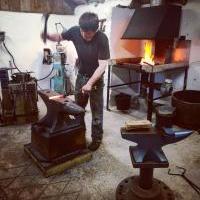-
Posts
586 -
Joined
-
Last visited
-
Yup, I've got more of the same. 1, don't worry about how long it takes to make something. 2. Practice Practice Practice. 3. you're time in the shop is never lost time. you're always gaining. Gaining experience, gaining knowledge, Gaining muscle memory. and if you're anything like me, you're gaining sanity which last I checked was pretty priceless. I don't get nearly as much time in my forge as I'd like to get. and frankly the new forge isn't completely set up yet. but the last several times I've been in the forge totaling some 5-10 total hours, I've produced very little more than hammered metal and a profound sense of contentment.
-
Thanks Frosty, Forge stand is light, and relatively mobile. but I may add wheels. I like the lay out you've made up. and yes, the power tools will stay in the other shop. One thing you left out is the quench tank but I'm sure I can find a useful location for that.
-
wood construction. currently, the "doors" are just openings one has a horse stall gate on it. I'll be adding a dutch door top there and the same on the other door. There is approximately 6' between the doors and the doors essentially start at the corners and go towards the center. So right now it's essentially open to the elements so the wood isn't super dry. Time will tell what adding doors will do to affect this. I don't plan on working large gates, but I will have some long projects. I've got a bar rail that I need to finish that I've been working on for some time now but haven't had the ability to work on it. Primarily I will be working small decorative stuff, knives, and axes.
-
I'm in the processing of setting up my new smithy. And one of the things I need to figure out is the location of my forge. I've got a 3 burner Specialty forge from Majestic Forge that has Front and back openings as well as a side door that drops down to allow for those oddly shaped items. My Smithy is a converted horse structure. It's 10'x20' with two large doors along one 20' side. My thought was to have the forge between the doors to ensure that I'm not ending up with a bad air situation. I'd like to know how far from the wall the forge should be to minimize the risk of fire.
-
Rebar is typically mixed alloys, along with the shape and how that shape is made probably has something to do with why heat would travel down it slower than round stock. at least that's my guess. Thanks guys. I currently have a 6x48" /9" Disc sander and a 1x30/5" disc sander. Is it easy to find ceramic consumables for those sizes?
-
What do you guys use to prep your layers for Damascus? Hard grinding wheel, Flappy paddle wheel, wire wheel? chemicals? I know that the point is to have them clean, and some of these leave residue and or grit behind which would effect the weld correct?
-
well, the stand is built, the floor of the forge sits at approximately 42". which If I stand with my arm bent puts my elbow right about a 90* angle. so I'm happy with that.
-
Recently purchased a Majestic Forge 3 burner specialty forge. Now I've got to build a decent stand for it. just wondering what height you have your forge at? Please take into account, I'm 6'5". So I'm thinking I'd like it a little taller than most. My previous gas forge just sat on my welding table. But my smithy no longer shares space with my welding tools. Do you guys have yours set at counter height or a little higher? Right now I'm thinking about putting the top of the stand at about 40"
-

Beginning Blacksmith on a budget
ThorsHammer82 replied to Blindman51's topic in Blacksmithing, General Discussion
Use what you have, to make what you need, until you find what you want. You can use all sorts of regular tools to make smithing tools. They may not always be the best tool for the job, but they'll get the job done. I've used a claw hammer and a rock as an anvil to make a bottle opener. Vise grips and channel locks make decent enough tongs to get stuff done, and if you use longer material, you don't need tongs. (read as you don't need tongs to make tongs) Punches and drifts can be made with the cost of material. Files and grinders can get spendy, but if you already do metal work, you should have most of that stuff all ready. The biggest thing is realizing that you don't need an English pattern anvil. Any hard and heavy hunk of metal can do the job for quite a bit of work. Railroad axles, forklift tines, and other heavy equipment parts are often used as anvils. Railroad track isn't the best option, but it can get the job done well enough. -
I don't/didn't have a big shop. Recent divorce is causing me to liquidate what I can and keep only what Is difficult or expensive to replace. I've already done the scrap yard run. Since I'd already done one the year before, There wasn't much to go this time. But in the next month or so, the forges, and my primary "Anvil" (read as large flat heavy piece of hard metal with useful shapes), the coal, and all the useful "hardenable" steel I've collected over the years are going to a friend of mine that wants to get into knife making. My post vice, and my post anvil. the few tongs I have, and my hammers will be all I get to keep for the next shop I build. which will hopefully be sooner rather than later. I say all this because it really gives some clarity of what is a must, and what is a luxury. Some times life tells you what you can take, and what you can't.
-
I was actually quoted for a "Smithing Pearls & Gems" with this "Use what you have, to make what you need, till your find what you want." That being said, there is so much that can be done with a 4.5" angle grinder, a ball pein and any pair of decent pliers. so long as you can get the material in and out of the fire and hold onto it while hitting it. but after a bit of experience, My list is as follows. 7" Grinder, 3 lbs Cross pein, and wolf Jaw tongs. The 7" moves a lot more material, and can cut through larger stock than a 4.5" grinder.
-
This is where I would go as well.
-

Pneumatic or mechanical?
ThorsHammer82 replied to ThorsHammer82's topic in Power Hammers, Treadle Hammers, Olivers
My intentions are not to go to full time production. just hobby/part time work. I understand that a lot of machines are all in the user's skill. And as in all things Smithing, Practice Practice Practice. I don't think I need anyting bigger than a #100 and actually don't plan on going that big. though If I want to do axes, and probably hammers, Maybe #100 or better is a good choice? Size is a non-issue, as the shop will be 40x40. -
Due to changes in my living situation, I've had to take a step back from smithing. As I look to the future, I'm trying to determine how my forge will change, and what I want in it. I know I'll get a Nimba Anvil, as they are manufactured about 2 hours away from me. But I also want to get a power hammer. I've never owned one, so that is where my question comes from. which type of power hammer to get? I have time to save up money to buy a good one. What I need to know is which type to get, Mechanical or pneumatic? Pro's and con's to both? And I figured this thread would be a good memorial for others in the future who have the same question. I want to get into pattern Damascus, and making axes. I already enjoy making architectural pieces, and knives. so those are the things that I would use the power hammer for.
-

Removing Grinding marks
ThorsHammer82 replied to ThorsHammer82's topic in Blacksmithing, General Discussion
Thanks Alan, I'll give that a try. I should still have one of those...



